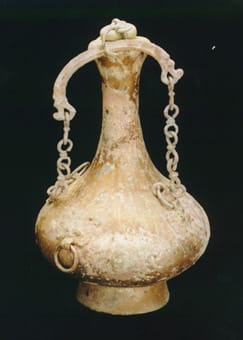Han Bronze Wine Vase With Handle, 206 BCE - 220 CE
Bronze
12
PF.4545
This slender-necked flask is representative of the Ha practice of imitating earlier bronze traditions. Combining the styles inherited from the Shang with ne technical skills, the Han were able to...
This slender-necked flask is representative of the Ha practice of imitating earlier bronze traditions. Combining the styles inherited from the Shang with ne technical skills, the Han were able to make an innovative contribution to th tradition of ritual object making. Th transformation of the lips into the shape of a blooming flower attests t artisan's commitment to tradition and innovation. The sensual shape of the flask adds to the beauty of thi vessel that was used to hold wine in ceremonies and banquets.
A traditional feature of early bronzeware is th two-headed dragon handle. This distinctive handle connects the sides of th vessel with two long chains held in the mouths of a dragon and an upside down
mask. Four large
animal masks are placed on top of the belly in positions representing the Fou Directions. The moti evolved from early bronzeware decor, probably out of the desire to propitiat the forces of the animal world to ensure a bountiful harvest and beneficia happenings.
A traditional feature of early bronzeware is th two-headed dragon handle. This distinctive handle connects the sides of th vessel with two long chains held in the mouths of a dragon and an upside down
mask. Four large
animal masks are placed on top of the belly in positions representing the Fou Directions. The moti evolved from early bronzeware decor, probably out of the desire to propitiat the forces of the animal world to ensure a bountiful harvest and beneficia happenings.
